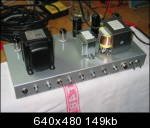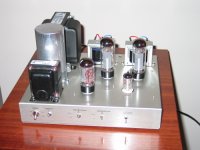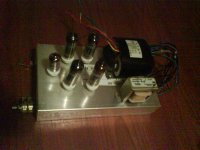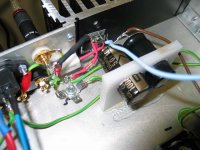Well, the feedback resistors need to be high enough value to not load down the tube Rp's for sure. Getting the feedback R networks tuned up optimally for 1-epsilon (epsilon being ultra tiny) loop gain will require some real tuning patience, so may not be commercially feasible. Also, the gain drift (aging) of the tubes will require re-tuning periodically I think for optimum performance.
Then again, the gain dropping noticeably below the 1-epsilon level may still be tolerable with a CCS tail, since the inversion will still be maintained, just will take more input signal current to get the See-Saw to shift. So input Z will just drop from 1/epsilon as the gain deteriorates.
Oh, I guess I forgot to mention explicitly (above) the standard pullup to B+ resistors on each plate. So each plate would have two feedback + one pullup resistor.
Then again, the gain dropping noticeably below the 1-epsilon level may still be tolerable with a CCS tail, since the inversion will still be maintained, just will take more input signal current to get the See-Saw to shift. So input Z will just drop from 1/epsilon as the gain deteriorates.
Oh, I guess I forgot to mention explicitly (above) the standard pullup to B+ resistors on each plate. So each plate would have two feedback + one pullup resistor.
Last edited:
But you may be worried about this Electrical Safety Authority Product Approval Requirements
Looks like you are breaking the law selling those things. $50,000 and up to a year in prison 🙁
Good point, but it's not just Ontario, see this from Wiki:
"The Canadian Electrical Code is published in several parts: Part I is the safety standard for electrical installations. Part II is a list of standards for the evaluation of electrical equipment or installations. (Part I requires that electrical products be approved to a Part II standard)"
Thanks DGTA, but I understand that Steve is in Peterborough Ontario, so I looked for the code in that province.
Smoking Amp - You say it yourself , it's not going to work perfect , you have right about the CCS in this case , but this CCS must be variable or controled to maintain the correct working of this circuit even when the tubes start to loose their transconductance over the time ( aging ) . But I think it deserve to give it a try .
I love this layout! Looks wonderful. (from the picture in post 240)
I must admit that it looks kinda cool too. First off it is nearly Hemi Orange, the same color as my 1973 Challenger. The offset symmetry looks different, but not ugly. I would use gloss black transformers, and knobs.
I can't pass judgement on the circuit, and don't care to trace someone elses work, since I am perfectly capable of designing my own, the layout may be "different" but if it works.....but GROUND the damn things please.....before you or one of your customers fry!
I can't speak on the legal issues, but I did consult a lawyer before selling my first amp or PC board, and was advised that you must show due dilligence in protecting your customers, AND take care of any KNOWN safety issues. Law does vary from country to country, and even state to state, but understand it isn't about who is right and who is wrong....it's usually the person with the best lawyer wins.
Remember the Ford Pintos that caught fire and burned people to death when hit from behind. Ford had to pay dearly for that. Why? Mustangs, Falcons, and a few other small and mid sized Fords and Mercurys had the same issue ( the trunk floor IS the gas tank). The ugly stuff started when it was discovered that Ford KNEW about the safety defects but chose not to fix them, believing that the limited legal issues would be cheaper than recalling a lot of cars. WRONG!
Chrish I noticed in one of your threads you, and I quote "Found this article on grounding on the Elliot Sound Products page Earthing (Grounding) Your Hi-Fi - Tricks and Techniques regarding the use of diodes, resistor and capacitor for lifting/breaking the loop."- What's up here, you know that's not legal right?
I also notice you are using an uncertified imported amp with a 100v transformer.
I can see your fascination with hummm, as you can't seem to wire a simple gainclone without it.
I see that you yourself GLUE your filter caps.
Let's have a peek at some of Mr.Saftey's work, check out the exposed transformers on the amplifier he built for his 13 year old son.
No, your not seeing things, those are high-voltage wires coming out of that amp. Not and endbell in site.
Shoot, that one amp does not even have a power cord, it looks like he just twists the wires together when he want's to have a listen.
I just thought I would share these for a laugh, talk about the horse calling the kettle black.
I also notice you are using an uncertified imported amp with a 100v transformer.
I can see your fascination with hummm, as you can't seem to wire a simple gainclone without it.
I see that you yourself GLUE your filter caps.
Let's have a peek at some of Mr.Saftey's work, check out the exposed transformers on the amplifier he built for his 13 year old son.
No, your not seeing things, those are high-voltage wires coming out of that amp. Not and endbell in site.
Shoot, that one amp does not even have a power cord, it looks like he just twists the wires together when he want's to have a listen.
I just thought I would share these for a laugh, talk about the horse calling the kettle black.
Attachments
I just thought I would share these for a laugh, talk about the horse calling the kettle black.
Dude, if it's a DIY amp, you can do anything you want. If you're selling to the public, you have to meet basic safety regs. Simple as that.
jeff
I don't think he grasped the difference between DIY and a manufacturer.
I don't think you grasp the difference between the public vs family and neighbors.
Chrish I noticed in one of your threads you, and I quote "Found this article on grounding on the Elliot Sound Products page Earthing (Grounding) Your Hi-Fi - Tricks and Techniques regarding the use of diodes, resistor and capacitor for lifting/breaking the loop."- What's up here, you know that's not legal right?
If you notice in that article, the mains earth ground is bonded directly to the chassis. It is only the circuit signal ground that uses the loop breaker.
It is the standard method of complying with the safety regs. and keeping ground loop problems out of the sound. Internal signal ground is not exposed, like the chassis, and the signal ground linkage to chassis (earth) ground only has enough slack in it to shave off the noise. So the RCA cable grounds (at signal ground potential) cannot vary from earth ground by more than the low level noise immunity barrier (so safe).
Last edited:
"Low Noise Electronic System Design" by C.D. Motchenbacher and J.A. Connelly
"Noise Reduction Techniques in Electronic Systems" by H.W. Ott
"Noise Reduction Techniques in Electronic Systems" by H.W. Ott
...while everyone checks on the legality of a loop breaker circuit, we will now pause for a word from our sponsors...😀
But you may be worried about this Electrical Safety Authority Product Approval Requirements
Looks like you are breaking the law selling those things. $50,000 and up to a year in prison 🙁
No problem, I'm sure Judge Judy will overturn it.
You want to see some unsafe practices, I have them on my web site too. I also carefully explain electrical safety, and why it is important. I have explained that there are only two people living in my house. My wife doesn't enter this room during testing, and she knows where the big red button is that kills all bench power, and the fire extinguisher. The bench is cold when I'm not home.
Fortunately she has not needed either, although I have smacked the kill button a couple times over the years when experiments went wrong. Here is a link to the most outrageous experiment I have tried in recent history.
There is a power supply from a Motorola two way radio base station. It is rated at 1500 volts at 1/2 Amp. It is used to test a 200 Watt SE guitar amp using a real transmitter tube, the 833A. All testing was done with a 1/4 inch sheet of Lexan between the amp and me. I had a fire extinguisher at my feet and my hand on the red button for most tests. After the amp proved stable, I connected up some guitars and annoyed the neighbors.
After the experiment ended the setup was torn down. It existed for about a week, then all the unsafe stuff was removed.
In my younger days I fixed guitar and Hifi amps, returning them to as designed condition. I have not done this in 30 years. Nothing leaves this room without a 3 wire cord and a grounded chassis.
My wife and I understand electrical safety. Many of my customers have been fellow engineers since there used to be nearly 1000 engineers in the plant where I work. They no NOTHING about electrical safety since it is NOT taught in school, and it is impossible to fry yourself on a 4 volt cell phone or a 7.5 volt two way radio. The biggest stuff in the building is 12 volt powered. Assume the customer knows nothing, because that is often the case.
The 833A SE Amp Prototype
Fortunately she has not needed either, although I have smacked the kill button a couple times over the years when experiments went wrong. Here is a link to the most outrageous experiment I have tried in recent history.
There is a power supply from a Motorola two way radio base station. It is rated at 1500 volts at 1/2 Amp. It is used to test a 200 Watt SE guitar amp using a real transmitter tube, the 833A. All testing was done with a 1/4 inch sheet of Lexan between the amp and me. I had a fire extinguisher at my feet and my hand on the red button for most tests. After the amp proved stable, I connected up some guitars and annoyed the neighbors.
After the experiment ended the setup was torn down. It existed for about a week, then all the unsafe stuff was removed.
In my younger days I fixed guitar and Hifi amps, returning them to as designed condition. I have not done this in 30 years. Nothing leaves this room without a 3 wire cord and a grounded chassis.
My wife and I understand electrical safety. Many of my customers have been fellow engineers since there used to be nearly 1000 engineers in the plant where I work. They no NOTHING about electrical safety since it is NOT taught in school, and it is impossible to fry yourself on a 4 volt cell phone or a 7.5 volt two way radio. The biggest stuff in the building is 12 volt powered. Assume the customer knows nothing, because that is often the case.
The 833A SE Amp Prototype
I notice you are red-plating there. I guess you would have it no other way!
By the way, gotta love the use of the Vise Grip there.
Last edited:
You want to see some scary home DIY stuff, take a look at these sites:
High Voltage - Fusor Input Power - messages
Science/Engineering/Technical forums • View topic - Lab upgrade
High Voltage - Fusor Input Power - messages
Science/Engineering/Technical forums • View topic - Lab upgrade
- Status
- Not open for further replies.
- Home
- Amplifiers
- Tubes / Valves
- Unusual amps..




